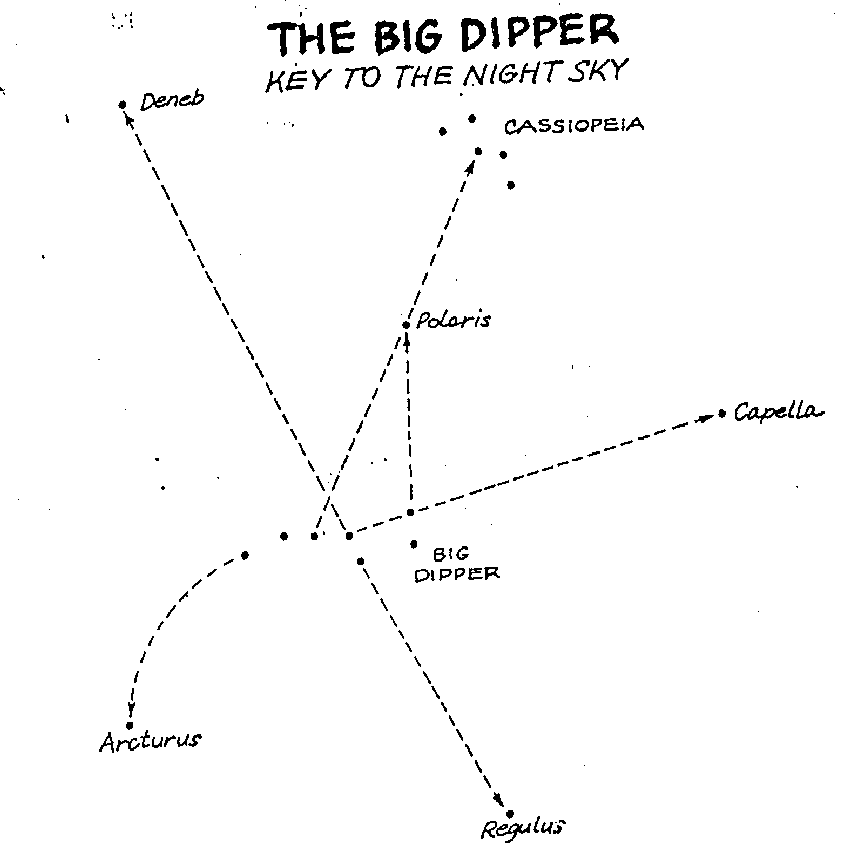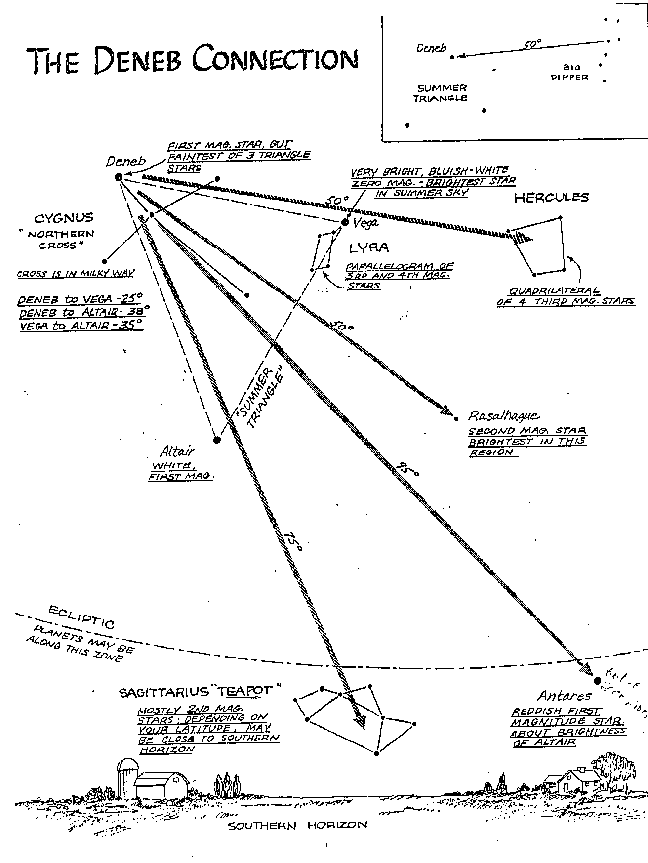
The best way to find your way around the night sky is by learning how to read a star chart and how to get around the sky using the sky coordinates. However, there are a few short cuts for those who are familiar with some of the more well known constellations like Ursa Major and Orion. The following pictures show some of the better star connections. If you click on the map, you will go to a copy of that map that is easy to print.
First lets begin with a easy way to judge distances. You have just what you need at the end of your arm.

The Big Dipper stars are arranged so that they conveniently point at most of the major bright stars in the sky. This diagram can be used at any time of any night of the year because the stars do not change their positions relative to one another. What does change is the direction that you face into space due to Earth's rotation and revolution. This means that although the Dipper itself will always be visible (if you live north of 38o north latitude) not all of the stars that are indicated in this diagram will be above the horizon at any one time.

The rising of Leo is always a sign of spring. How do you find it? Easy. Find the Big Dipper again. Find Merek, the root of the bear's tail, follow the line of the Dipper's bowl to Phecda, then follow the line 45o to the bright star Regulus. Merek and Phecda are dimmer than Regulus. Merek is magnitude 2.44 and Phecda is 2.44, but Regulus is 1.35. Regulus is the 'dot' of the backwards question mark that make up Leo's head and mane.
The stars Dubhe and Merak are called the pointer stars because they point to Polaris, the North Star, but they also point to Castor and Pollux, the twin stars in Gemini.

Deneb is the bright star in Cygnus, the Swan lso called the Northern Cross. It is also one of the three stars that make up the Summer Triangle and one of the brightest stars in the summer sky. Deneb is of magnitude 1.25. Use the following map to help find some of the other summer constellations. Another star in the Summer Triangle is Altair, in the constellation, Aquila. Altar is a white star of magnitude 0.77. Vega is the third star in the Summer Triangle. With a magnitude of 0.04, it is the brightest star in the summer sky, Don't miss Antares. Antares is called the 'rival of Mars' because of its oranges-red color. It is the double star around magnitude 1.0.

Autumn is the smell of burning leaves and new crayons, bright red apples and orange pumpkins and cystral clear skies. It is also time for Pegasus and its treasure, the Andromeda Galaxy. Andromeda is the closest galaxy to our own and it is also a galaxy. You can see it with the naked eye. Using the map, look for a fuzzy blob right above the second star in the top line of the constellation, Andromeda. The Andromeda Galaxy has a magnitude of around 4. It is easy to see with binoculars. It is beautiful in a telescope.

The great square of Pegasus can help you find other constellations in the Autumn sky.

I really thank that because it is cold out this time of year that God put the best constellations in the winter sky to make it worth the braving the cold. I love the winter sky. You must take the time to find the constellations this time of year. Use the Orion Connection. Orion's, the Hunter's, left shoulder is the star Betelgeuse, a red giant with the magnitude of 0.8. It points up to the twin stars Pollux (1.15) and Castor (1.97) of Gemini. Gemini is another very bright constellation. The stars in Orion's belt point to three other very bright stars. The lower left star in his belt points to the brightest star in the northern hemisphere, Sirius (-1.45) of Canis Major. The middle star in Orion's belt points up to Capella (0.08), the bright star in the constellation Auriga. The third star in the belt of Orion points to Aldebaran (0.85) in Taurus. Aldebaran is the 'eye of the bull' but his shoulder is the star cluster, the Pleiades. These are beautiful constellations. You must not miss learning these. They will bring you pleasure all winter.

![]()

 View Guestbook
View Guestbook